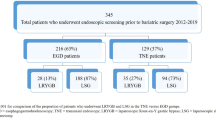Abstract
Background
Esophagogastroduodenoscopy (EGD) is an important facet of the preoperative evaluation for bariatric surgery. Morbidly obese patients are at high risk for airway complications during this procedure, and an attractive alternative is transnasal EGD. This report describes a series of patients evaluated successfully using this technique.
Methods
All patients undergoing preoperative transnasal small-caliber EGD for morbid obesity surgery between September 2004 and June 2005 at a Veterans Affairs Hospital were included in the analysis. The variables assessed were the adequacy of the examination, patient tolerance, the need for sedation, and the ability to perform interventions.
Results
The study enrolled 25 patients (17 men and 8 women) with an average age of 55 years (range, 44–63 years) and an average body mass index (BMI) of 47 kg/m2 (range, 38–69 kg/m2). All the patients met the 1991 National Institutes of Health (NIH) Consensus Conference Criteria for bariatric surgery and were undergoing preoperative evaluation. The most common comorbidities were hypertension (82%), diabetes mellitus (80%), and obstructive sleep apnea (68%). All 25 patients had successful cannulation of the duodenum’s second portion with excellent tolerance. There were no sedation requirements for 23 (92%) of the 25 patients. Significant pathology was found in 14 (56%) of the 25 patients, including hiatal hernia (28%), gastritis (16%), esophageal intestinal metaplasia (16%), esophagitis (12%), gastric polyps (8%), gastric ulcer (4%) and esophageal varices (4%). Biopsies were indicated for 12 patients and successful for all 12 (100%).
Conclusion
Transnasal small-caliber EGD is a feasible and safe alternative to conventional EGD for the preoperative evaluation of patients undergoing bariatric surgery. It requires minimal to no sedation in a population at high risk for complications in this setting. In addition, this technique is effective in identifying pathology that requires preoperative treatment and offers a complete examination with biopsy capabilities. This technique should be considered for all morbidly obese patients at high risk for airway compromise during EGD.

Similar content being viewed by others
References
Alami RS, Morton JM, Sanchez BR, Curet MJ, Wren SM, Safadi BY (2005) Laparoscopic Roux-en-Y gastric bypass at a veterans affairs and high-volume academic facilities: a comparison of institutional outcomes. Am J Surg 190: 821–825
Arrowsmith JB, Gerstman BB, Fleischer DE, Benjamin SB (1991) Results from the American society for gastrointestinal endoscopy/U.S. Food and Drug Administration collaborative study on complication rates and drug use during gastrointestinal endoscopy. Gastrointest Endosc 37: 421–427
Birkner B, Fritz N, Schatko W, Hasford J (2003) A prospective randomized comparison of unsedated ultrathin versus standard esophagogastroduodenoscopy in routine outpatient gastroenterology practice: does it work better through the nose? Endoscopy 35: 647–651
Dean R, Dua K, Massey B, Berger W, Hogan WJ, Shaker R (1996) A comparative study of unsedated transnasal esophagogastroduodenoscopy and conventional EGD. Gastrointest Endosc 44: 422–424
Dumortier J, Napoleon B, Hedelius F, Pellissier PE, Leprince E, Pujol B, Ponchon T (2003) Unsedated transnasal EGD in daily practice: results with 1,100 consecutive patients. Gastrointest Endosc 57: 198–204
Dumortier J, Ponchon T, Scoazec JY, Moulinier B, Zarka F, Paliard P, Lambert R (1999) Prospective evaluation of transnasal esophagogastroduodenoscopy: feasibility and study on performance and tolerance. Gastrointest Endosc 49: 285–291
Faulx AL, Catanzaro A, Zyzanski S, Cooper GS, Pfau PR, Isenber G, Wong RCK, Sivak MV, Amitabh C (2002) Patient tolerance and acceptance of unsedated ultrathin esophagoscopy. Gastrointest Endosc 55: 620–623
Preiss C, Charton JP, Schumacher B, Neuhaus H (2003) A randomized trial of unsedated transnasal small-caliber esophagogastroduodenoscopy (EGD) versus peroral small-caliber EGD versus conventional EGD. Endoscopy 35: 641–646
Saeian K (2002) Unsedated transnasal endoscopy: a safe and less costly alternative. Curr Gastroent Rep 4: 213–217
Saeian K, Staff D, Knox J, Binion D, Townsend W, Dua K, Shaker R (2002) Unsedated transnasal endoscopy: a new technique for detecting and grading esophageal varices in cirrhotic patients. Am J Gastroenterol 97: 263–266
Saeian K, Townsend WF, Rochling FA, Bardan E, Dua K, Phandis S, Dunn B, Darnell K, Shaker R (1999) Unsedated transnasal EGD: an alternative approach to conventional esophagogastroduodenoscopy for documenting Helicobacter pylori eradication. Gastrointest Endosc 49: 297–301
Safadi BY, Kieran JA, Hall RG (2004) Introducing laparoscopic Roux-en-Y gastric bypass at a veterans affairs medical facility. Am J Surg 188: 606–610
Shaker R, Saeian K (2001) Unsedated transnasal laryngo-esophagogastroduodenoscopy: an alternative to conventional endoscopy. Am J Med 111: 153S–156S
Zaman A, Hahn M, Hapke R, Knigge K, Fennerty B, Katon RM (1999) A randomized trial of peroral versus transnasal endoscopy using an ultrathin videoendoscope. Gastrointest Endosc 49: 279–284
Author information
Authors and Affiliations
Corresponding author
Rights and permissions
About this article
Cite this article
Alami, R.S., Schuster, R., Friedland, S. et al. Transnasal small-caliber esophagogastroduodenoscopy for preoperative evaluation of the high-risk morbidly obese patient. Surg Endosc 21, 758–760 (2007). https://doi.org/10.1007/s00464-006-9101-z
Received:
Accepted:
Published:
Issue Date:
DOI: https://doi.org/10.1007/s00464-006-9101-z




